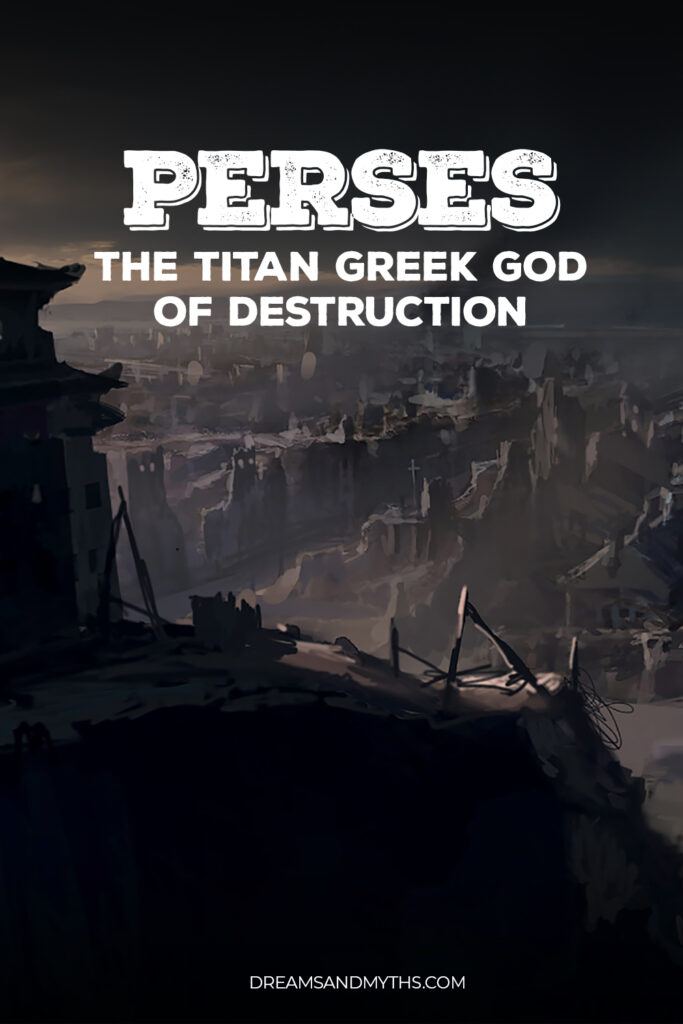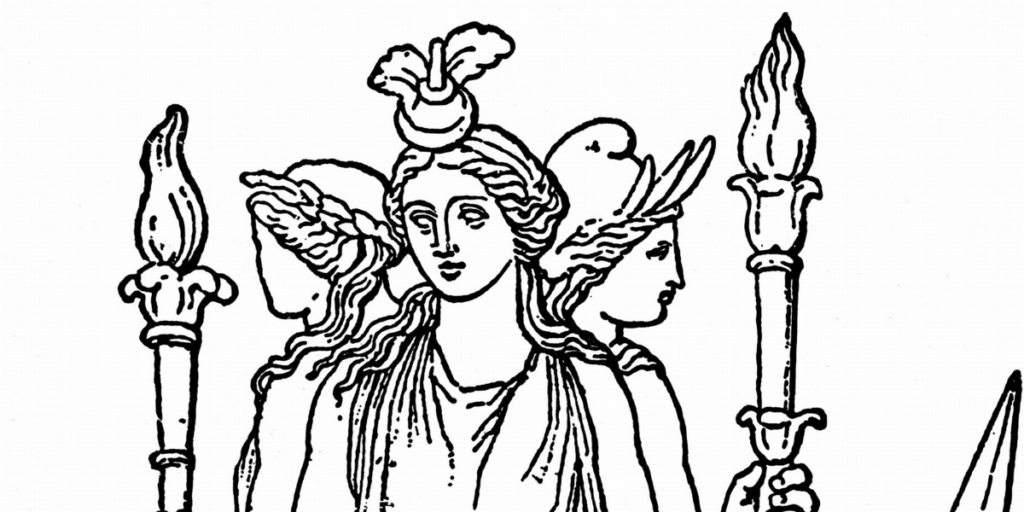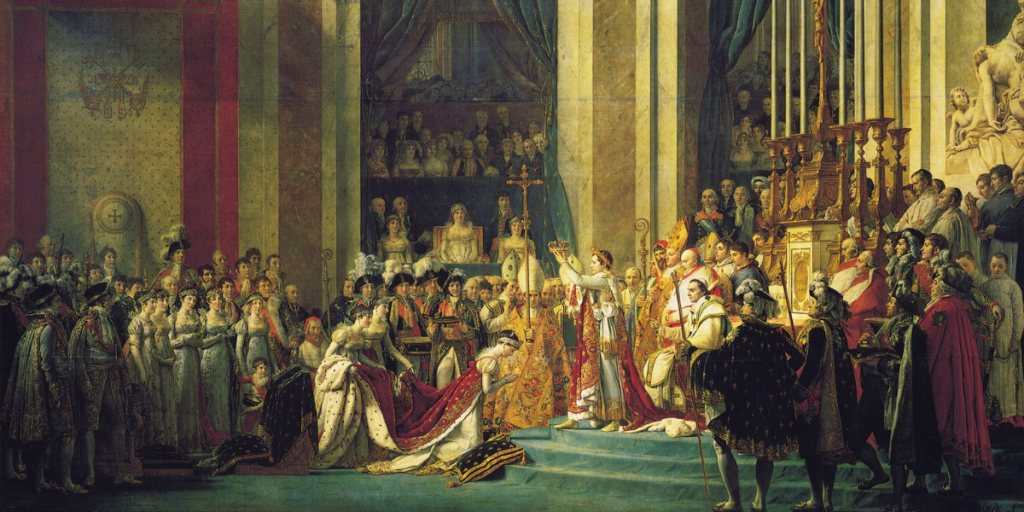There was a time before the Olympians when the Titans ruled. The Titans were a group of ancient gods in Greek mythology. Titans’ ancestors originated in the depths of chaos.
Primordial deities, the original Titans embodied the most basic elements of planet Earth and the cosmos. Their offspring, however, looked like a cross between humans and giants, and they inherited their magical abilities.

The Olympians of the Greek Pantheon tend to get more attention than the Titans. Nonetheless, their significance in Greek mythology persists.
The history of one Titan, Perses, has been buried by the sands of time. Perses, the god of destruction and wrath, is a second-generation titan. He symbolizes the havoc and confusion war can wreak, portraying the destruction of land and life.
This article will present an account of his life and some lesser-known facts about his life.
Origin of Perses
More information is needed regarding the Perses. Poems and literature barely touch on him, despite his significance to ancient Greeks. Even in Greek mythology, his part was minor.
Hesiod’s “Theogony” is widely regarded as the definitive work tracing immortal ancestry. You can find references to Perses in the Homeric Hymns and Apollo dorus’s writings.
Perses was born to Titan parents Crius and Eurybia. Both Crius, the deity of the heavens, and Eurybia, the goddess of maritime supremacy, were important figures in Greek mythology. In the beginning, there were the first primordial deities from whom the two older Titans emerged.
The astrological deity Pallas was his sibling, and Astraeus, the god of the winds, was another. A Titan named Asteria was the wife of Perses. She was Phoebe and Coeus’s daughter.
The background and upbringing of Perses, the main character, could be explored more. As with many of the Titans, the Greeks did not worship Perses.
Greeks would only appeal for help during times of war. Besides that, however, there were no other religious buildings in Perses.
Marriage
Asteria and Perses were married. Asteria, daughter of Titan parents Coeus and Phoebe, was a deity. She was a goddess of the underworld and necromancy and had the immortality of an Olympian.
Asteria had a reputation for engaging in witchcraft and conversing with the dead. However, according to legend, she could also foretell the future.
Children

A potent offspring was born to the goddess of necromancy and the deity of destruction. They had a daughter, Hecate, who would become the Greek goddess of witchcraft, ghosts, and other supernatural phenomena.
Everything secretive and shady fell under Hecate’s sphere of influence. Similar to her mother, she engaged in necromancy and magic.
She even learned to identify dangerous plants and establish contact with the other side. As a result, Hecate became known as the “Queen of Ghosts.”
Certainly, Hecate’s fame exceeds that of her parents, the Greek gods. She was so incredibly wonderful that not even Zeus could ignore her. In addition to the sky and the underworld, she had control over everything in the known universe.
Other than Hecate, Perses didn’t have any other children. Circe, Scylla, Empusa, Medea, and Aegialeus, children of Hecate, carried on his tradition.
Depictions
Only a handful of depictions of Perses in art have been created throughout time. There are fewer artistic depictions of Perses and the other Titans than of the Twelve Olympians.
Artists in the modern era have taken considerable artistic license with the deity’s physical representation.
Perses is typically portrayed as a malevolent foe when a battle is raging. Most depictions of Perses, like those of many other Titans, have him towering over regular humans.
Experts have speculated that a more animalistic likeness of Perses was initially intended. It turns out that Perses is a dog personified. All the constellations in the sky are related to Titan Crius and his three sons, and they all contain animal characteristics.
On the other hand, his siblings Pallas and Astraeus took the shape of a large goat and a horse. Their ram father, Crius, was the inspiration for their name.
Symbolism
In mythology, Perses represented the destructive force. He was a god of war’s worst sides, and his violence and aggression were universally symbolic.
However, the god of battle, Perses, is not the only one. He may not have become as well-known as Ares, but he still left an impression.
There were rumors that Perses was a very violent man. The ancient Greeks called him “The Destroyer” because he often fought with warriors to help them conquer new territories. He took great pleasure in the anarchy and bloodshed of battle.
Earlier, we established no temple cults in honor of the Perses. Yet, the Greeks continued to seek his blessing. Moreover, praying to Perses for protection in combat was a common practice among soldiers.
When they sought his help, it was for more than just safety. The Greeks looked to Perses for guidance, and with his help, they were able to defeat their most formidable foes.
While the god’s intellect was greater than that of mortals, it was most helpful in the realm of war strategy. Hesiod claims that Perses was also a brilliant strategist. Word on the street has it that his wits might let him triumph in battle even when outnumbered.
In the eyes of some academics, Perses was the god of war and peace. Peace was a rare occurrence in ancient Greece. And yet, in other versions of his story, Perses is shown as having other motivations besides destruction.
Violence was common as people feared being killed over petty arguments and territorial disputes.
Many ancient Greeks placed their hopes in Perses for reasons beyond military success. Instead, they hoped that the fighting would cease quickly so that they could take advantage of the subsequent calm.
Many people looked to Perses as a metaphor for what happened once hostilities were resolved, even if the respite was only temporary.
Legacy of Perses
The god of war known as Perses appeared early in mythology. However, since he is a Titan of the second generation, he predates even the Olympians. Although the Titan Perses isn’t pivotal in Greek mythology, he is significant to the religion’s origin story.
Before the appearance of Ares and Athena, he aided the ancient Greeks in forging a path of destruction in conflict. He possesses the innately violent character of a warrior and an insatiable need for blood.
For better or worse, the god embodied the forces of war. Nevertheless, the end of wars offered the tranquility that the ancient Greeks had yearned for all along, even in the wake of widespread destruction.
Over time, Zeus and the Olympians were able to defeat the Titans and claim victory. It needs to be discovered how successful Perses was in the Titanomachy. It’s uncertain if he served in the Great War or not.
Scholars agree on one point, however: he was not among the Titans sent to Tartarus. Therefore, most believe the person disappeared into obscurity or helped the Greek people. Moreover, his apparent absence from later narratives lends credence to the theory that other Greek gods, such as Ares, usurped his duties.
Confusion With The King of Colchis

A mythical king of Greek mythology bore the name Perses; however, the name was also shared by a Titan god of the same name. In the stories of Aeetes and Medea, King Perses plays a relatively minor role.
Having been born to Helios and the Oceanid Perseis, Perses was a half-brother to the goddesses Aeetes, Circe, and Pasiphae.
Aeetes is most known as King of Colchis during the Argonauts’ exploits, Circe as a famous witch, and Pasiphae as the wife of Crete’s King Minos, but Perses is the least well-known among the four siblings.
According to Greek mythology, Perses was formerly the monarch of Tauric Chersonese, an area that is now known as the Crimean Peninsula.
Although Perses is well-known, it is not for his reign as king of Tauric Chersonese but rather for his eventual ascension to the throne of Colchis.
Aeetes, Perses’s brother, ruled Colchis for a long time. It was prophesied that if the Golden Fleece ever left Colchis, Aeetes would lose his empire, and so Aeetes lived in constant fear of that day.
With the aid of Aeetes’s daughter, Medea, Jason and the Argonauts successfully fled with the Golden Fleece.
There are conflicting accounts of how Perses came to usurp Aeetes’s rule in Colchis, with some describing a peaceful transfer of power in which the younger brother was locked up and others describing a full-scale civil war amongst the offspring of Helios.
Due to the lack of safe havens in Greece, Medea and her son Medus eventually made their way back to the land of their birth, Colchis.
However, there are also slightly more complex versions of the story in that Medea kills her uncle and puts her father back on the throne.
Some Lesser Known Facts About Perses
- Perses, a Titan god from the second generation, was revered as the god of devastation. He belonged to the second dynasty of the Titans.
- He was revered by the Ancient Greeks, who had an extraordinarily large pantheon.
- The name of the battle god Perses is linked to the phrase “sack in war” or “to lay waste,” both of which are synonyms for the Greek word persô. His given name literally means “to destroy” in other languages.
- As “The destroyer,” Perses was known to aid others in battle and in the conquest of new territories. Given his role as a war god, Perses probably had a penchant for anarchy and destruction.
- When the Greeks went to war, they prayed to their god of war for inspiration and courage. So likewise, prayers to the god Perses were made before battles and wars.
- In addition to the god Perses, two others in Greek mythology have the same name.
- You’ll discover Perses in the Canis Major, or Dog, constellation.
Summary
In Greek mythology, the Titans were a race of giants that governed the Earth before being defeated by Zeus and the Olympian Gods in the titanic conflict known as the Titanomachy.
Perses, the Titan deity of Necromantia and the spouse of Asteria, was the offspring of Crius and Eurybia, the first dynasty of Titan gods.
The myth and mythology of Perses, the god of destruction, and the Titans, that has been passed through the ages is significant to the study of the Classical Greek world and its history.
The ancient Greeks believed that these gods and goddesses, like Perses, looked human but actually held mystical abilities.
